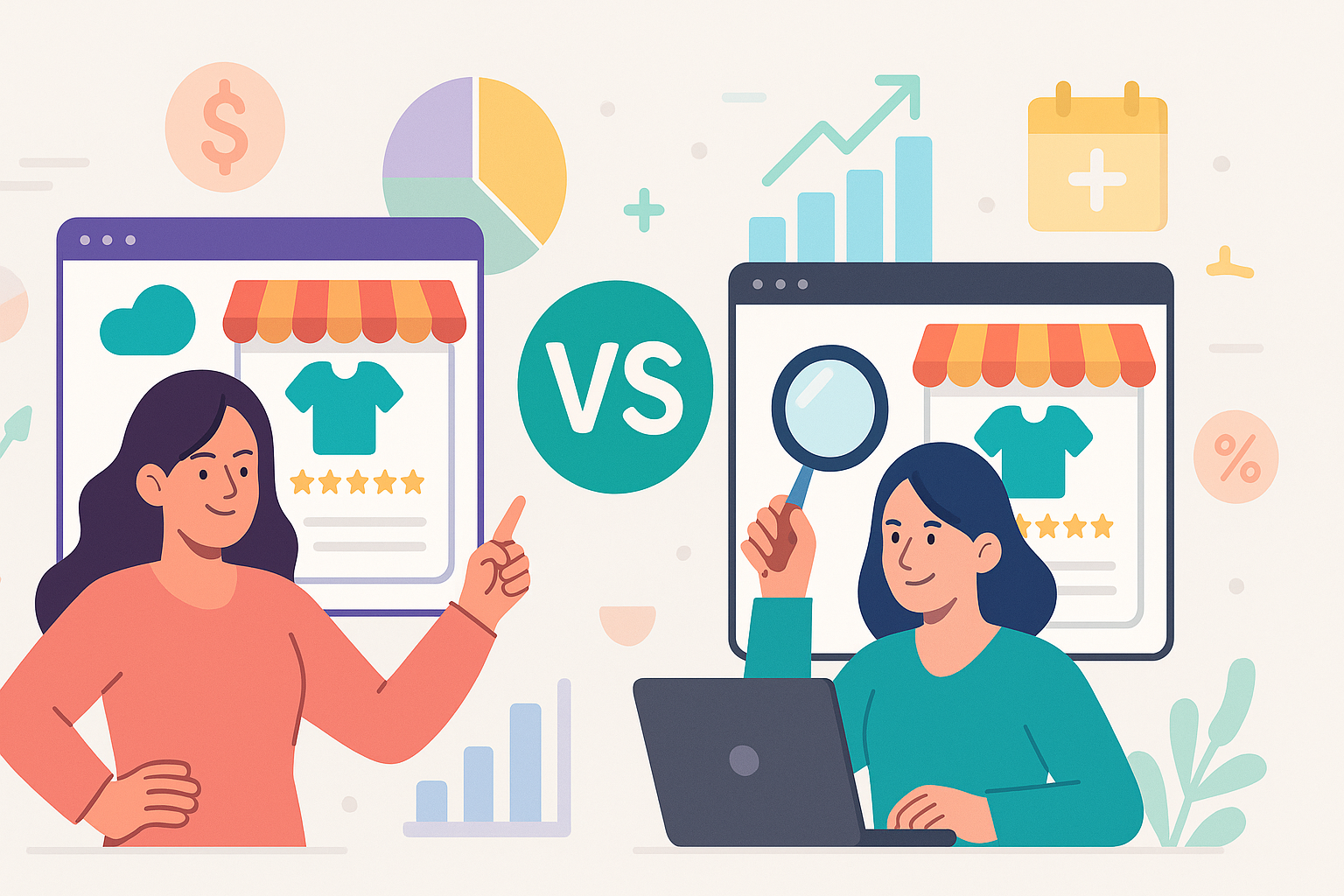Mastering Digital Marketing for Luxury Brands: Exclusivity, Data, and Performance
by Francisco Kraefft on 31 Mar, 2025
Marketing luxury isn't merely about selling products; it's about cultivating desire, communicating heritage, and upholding an aura of exclusivity that resonates deeply with a discerning clientele. In the digital realm, achieving this delicate balance requires a strategy far removed from mass-market tactics. Standard digital marketing approaches often dilute brand equity and fail to capture the nuances of the luxury customer journey. Success hinges on a bespoke approach – one that leverages sophisticated digital channels to enhance, not erode, the inherent value and mystique of your brand. This requires a deep understanding of the affluent consumer's mindset, meticulous execution across all touchpoints, and a relentless focus on data-driven performance to ensure every digital interaction reinforces your brand's prestige and drives meaningful results. Let's explore how you can master digital marketing for your luxury brand.
The Unique Landscape: Why Luxury Digital Marketing Demands a Different Approach
Luxury brands operate within a unique ecosystem defined by heritage, craftsmanship, exclusivity, and emotional connection. Translating these pillars into the digital space presents distinct challenges and opportunities. Unlike mass-market brands focused solely on volume and accessibility, your goal is often controlled reach and qualified engagement.
Here’s why a specialized approach is non-negotiable:
- Brand Equity Protection: Your brand's reputation is paramount. Digital activities must meticulously safeguard and enhance perceived value. Poorly executed campaigns, generic messaging, or association with inappropriate platforms can inflict significant damage.
- The High-Touch Expectation: Luxury consumers expect personalized, seamless experiences, both online and offline. Your digital presence must mirror the exceptional service found in your boutiques. This includes intuitive navigation, high-fidelity visuals, and responsive, knowledgeable customer support accessible through digital channels.
- Exclusivity in a Digital World: How do you maintain scarcity and desire when digital platforms are inherently open? Strategies involve curated content, private online events, loyalty programs with tiered digital access, and carefully controlled distribution channels.
- The Considered Purchase Journey: Acquiring a luxury item is rarely an impulse buy. The customer journey is often longer, involving extensive research, brand immersion, and multiple touchpoints. Your digital strategy must nurture prospects through this complex funnel, providing value and reinforcing desire at each stage.
- Beyond Demographics: Targeting the affluent requires more than just income data. It involves understanding psychographics, lifestyle choices, values, and specific interests. Data analysis must go deeper to identify true potential customers who align with your brand's ethos.
Standard digital marketing metrics like click-through rates or broad reach are insufficient. We must focus on metrics reflecting quality engagement, lead qualification, brand sentiment, and ultimately, contribution to high-value sales and customer lifetime value. Ignoring these nuances means risking brand dilution and wasted marketing investment.
Crafting an Immersive and Exclusive Online Presence
Your website and digital platforms are not just online brochures; they are the virtual flagships of your luxury brand. They must exude the same level of sophistication, quality, and attention to detail as your physical products and stores. Mediocrity here is unacceptable.
Key elements for an exceptional online presence include:
- Sophisticated UX/UI Design: Navigation should be intuitive yet elegant. The user experience (UX) must be seamless across all devices (desktop, tablet, mobile), prioritizing clean aesthetics, uncluttered layouts, and subtle animations that enhance, rather than distract. The user interface (UI) should incorporate high-quality typography, brand-consistent color palettes, and an overall feeling of digital luxury.
- High-Fidelity Visuals: Invest heavily in professional photography and videography. Product shots need exquisite detail, capturing texture and craftsmanship. Lifestyle imagery must evoke the desired aspiration and emotional connection. Consider 360-degree views, interactive elements, and high-resolution video content.
- Immersive Content Experiences: Move beyond static pages. Utilize technology to create engaging experiences: virtual tours of ateliers, interactive timelines showcasing brand heritage, configurators allowing product customization, or behind-the-scenes glimpses into the creation process. These elements deepen engagement and reinforce brand value.
- Mobile-First Excellence: Affluent consumers are heavy mobile users. Your digital presence must be flawlessly optimized for mobile, ensuring fast loading times, easy navigation, and a visually stunning experience on smaller screens. A poor mobile experience signals a lack of attention to detail – fatal for a luxury brand.
- Performance and Security: Slow loading times or security vulnerabilities instantly erode trust and perceived quality. Optimize images and code for speed. Implement robust security measures to protect customer data, especially crucial when handling high-value transactions and personal information.
- Subtle Exclusivity: Consider incorporating elements like members-only sections, early access previews for subscribers, or password-protected areas for exclusive content or collections. This reinforces the feeling of belonging to an inner circle.
Your digital storefront must be a destination in itself, reflecting the pinnacle of quality and providing an experience that captivates and reassures your discerning audience.
Content Strategy: Weaving Narratives of Heritage and Desire
Content marketing for luxury brands transcends simple product descriptions. It's about masterful storytelling – weaving narratives that highlight heritage, craftsmanship, lifestyle, and the emotional resonance of your offerings. Your content should create desire, foster community, and solidify your brand's position as a leader in its category.
Effective content strategies for luxury often include:
- Brand Storytelling: Dive deep into your brand's history, the founder's vision, pivotal moments, and the evolution of your craft. Use long-form articles, captivating videos, and perhaps even interactive timelines to bring this heritage to life.
- Artisan and Craftsmanship Focus: Showcase the meticulous skill, rare materials, and time-honored techniques behind your products. Interviews with artisans, behind-the-scenes footage of the creation process, and detailed explanations of unique features resonate strongly with consumers who appreciate quality and authenticity.
- Lifestyle Integration: Position your brand within a broader aspirational lifestyle. Create content around art, culture, travel, philanthropy, or other areas that align with your target audience's interests and values. This broadens appeal and context beyond the product itself.
- Strategic Influencer Collaborations: Forget mass-reach influencers promoting fleeting trends. Partner selectively with credible figures, micro-influencers, or respected authorities within specific niches (e.g., renowned architects for a luxury furniture brand, respected sommeliers for fine wines) whose personal brand and audience genuinely align with your values. Authenticity is key.
- Curated User-Generated Content (UGC): Encourage sophisticated UGC by creating branded hashtags or contests that inspire creativity. However, curation is critical. Only feature UGC that meets your high aesthetic standards and reinforces the desired brand image.
- Exclusive Content Formats: Offer value beyond the publicly accessible. Consider beautifully designed digital magazines, insightful white papers on relevant luxury trends, exclusive video interviews, or early access webinars for your most loyal customers.
- Video Dominance: Invest in high-production value video content – brand films, mini-documentaries, tutorials showcasing product use in an elegant context, and visually stunning social media clips.
Your content must consistently communicate quality, exclusivity, and the unique story only your brand can tell. It’s an investment in building long-term brand equity and customer loyalty.
Precision Targeting & Paid Media: Reaching the Affluent Effectively
Reaching the right audience in the luxury sector requires precision, not just broad strokes. Paid media strategies must be carefully calibrated to connect with high-net-worth individuals (HNWIs) and ultra-high-net-worth individuals (UHNWIs) without compromising brand exclusivity or appearing intrusive.
Key considerations for paid media include:
- Advanced Audience Segmentation: Go beyond basic demographics. Leverage data platforms and first-party data to segment audiences based on:
- Psychographics: Values, attitudes, lifestyle choices.
- Interests: Specific luxury categories (yachting, fine art, haute couture), high-end travel, exclusive clubs, philanthropic activities.
- Behavioral Data: Past purchase history (where available and privacy-compliant), engagement with luxury content, attendance at exclusive events.
- Lookalike Audiences: Build audiences based on your existing high-value customers, ensuring a focus on quality over quantity.
- Strategic Platform Selection: Not all platforms are created equal for luxury.
- Search Engine Marketing (SEM): Target high-intent, specific keywords related to your brand and products (e.g., "Patek Philippe Calatrava price," "custom bespoke Savile Row suit"). Focus on brand terms and long-tail keywords indicating strong purchase intent. Negative keywords are crucial to filter out irrelevant traffic.
- Social Media Advertising: Platforms like LinkedIn (targeting by job title, seniority, industry), Instagram, and Facebook (leveraging sophisticated interest and behavioral targeting) can be effective. Pinterest also holds potential for visual discovery. The creative and messaging must be highly refined and contextually appropriate.
- Programmatic Advertising: Utilize programmatic platforms that allow for precise targeting based on contextual relevance (appearing on luxury news sites, financial journals), curated audience segments, and even offline data integration (with appropriate privacy considerations). Prioritize premium inventory and brand safety.
- High-Impact Creatives: Ad visuals and copy must be exceptional – reflecting the quality and aesthetic of your brand. Avoid generic stock photos or overly promotional language. Focus on elegance, storytelling, and a clear value proposition.
- Geo-Targeting and Geo-Fencing: Target specific affluent neighborhoods, cities, or even attendees of exclusive events (e.g., art fairs, classic car shows) where permitted and relevant.
- Budget Allocation & ROI Focus: Luxury keywords and premium placements are expensive. Budgets must be allocated strategically, with a rigorous focus on measuring return on investment (ROI) based on qualified leads, high-value conversions, and contribution to overall brand health, not just clicks.
Effective paid media for luxury is about surgical precision, quality placements, and messaging that resonates with the exclusivity and sophistication expected by your target audience. We leverage data to ensure every dollar spent contributes to meaningful engagement and acquisition.
The Critical Role of Data & Analytics in Luxury Performance Marketing
In the realm of luxury digital marketing, data isn't just informative; it's foundational. Gut feelings and anecdotal evidence are insufficient when brand reputation and significant investments are at stake. A data-driven approach allows you to understand your audience deeply, measure the true impact of your efforts, personalize experiences, and optimize for performance.
Here’s how data elevates luxury marketing:
- Measuring What Truly Matters: Move beyond vanity metrics. Focus on KPIs that reflect genuine business impact for luxury brands:
- Engagement Quality: Time on site, depth of visit, interaction with key content (e.g., configuration tools, heritage pages).
- Lead Quality Score: Assessing leads based on demographic fit, engagement level, and expressed interest.
- Brand Sentiment Analysis: Monitoring social listening channels and reviews to gauge brand perception.
- Assisted Conversions: Understanding how different digital touchpoints contribute to the final sale, even if it happens offline.
- Customer Lifetime Value (CLV): Tracking the long-term value generated by customers acquired through digital channels.
- Cost Per Qualified Lead/Acquisition: Measuring efficiency in attracting the right customers.
- Sophisticated Attribution Modeling: The luxury purchase journey is rarely linear. Customers may interact with your brand across multiple digital channels (social media, search, website) and offline touchpoints (boutique visits, events) over weeks or months. Implementing advanced attribution models (e.g., data-driven, position-based) provides a clearer picture of which channels and campaigns are most influential.
- Personalization at Scale: Leverage data (behavioral, transactional, preference-based) to deliver personalized experiences. This can range from tailored website content and product recommendations to segmented email campaigns featuring relevant collections or exclusive invitations. Personalization enhances the feeling of exclusivity and individual attention.
- Audience Insights: Analyze website traffic, social media engagement, and campaign performance data to gain deep insights into your target audience's preferences, online behavior, content affinities, and geographic concentrations. This informs future strategy and creative development.
- A/B Testing and Optimization: Continuously test different creatives, messages, landing pages, and targeting parameters. Use data to determine what resonates best with your specific luxury audience segments and optimize campaigns for maximum impact and efficiency.
At iVirtual, we embed data analysis into every stage of the process. We believe that rigorous measurement and insightful interpretation are essential for driving predictable growth and maximizing the return on your digital marketing investments in the competitive luxury landscape.
Omnichannel Integration & The Future of Luxury Digital Experiences
The ultimate goal is a seamless fusion of online and offline experiences, creating a cohesive brand universe for the luxury consumer. Digital should enhance, not replace, the physical. Furthermore, staying ahead requires anticipating and strategically adopting emerging technologies and trends.
Key areas of focus include:
- Bridging Online and Offline:
- Click-and-Collect/Reserve in Store: Allow customers to browse online and seamlessly transition to a boutique experience.
- Clienteling Tools: Equip sales associates with digital tools providing customer profiles, purchase history, and preferences, enabling personalized in-store interactions informed by online behavior.
- Exclusive Event Invitations: Use digital channels to invite loyal customers to private viewings, collection launches, or VIP events, strengthening the relationship.
- Post-Purchase Digital Engagement: Follow up offline purchases with relevant digital content, care guides, or loyalty program updates.
- Immersive Technologies:
- Augmented Reality (AR): Offer virtual try-ons for watches, jewelry, or even see how furniture looks in a customer's home. AR enhances consideration and bridges the imagination gap.
- Virtual Reality (VR): Create immersive brand experiences, virtual showroom tours, or transportive narrative journeys accessible from anywhere.
- The Metaverse and NFTs: While still evolving, explore potential applications cautiously. Consider limited-edition digital collectibles (NFTs) linked to physical products, exclusive virtual spaces for brand communities, or virtual fashion items. The key is authenticity and alignment with brand values, avoiding gimmickry.
- Hyper-Personalization: Future advancements in AI and machine learning will enable even deeper levels of personalization, anticipating customer needs and delivering uniquely tailored content, offers, and experiences across all touchpoints in real-time.
- Sustainability and Ethical Messaging: Increasingly important to affluent consumers. Authentically communicate your brand's commitment to sustainability, ethical sourcing, and responsible practices through dedicated digital content and transparent reporting.
- Data Privacy and Trust: As data usage becomes more sophisticated, maintaining transparency and robust data privacy practices is paramount for retaining the trust of discerning clientele.
The future of digital marketing for luxury brands lies in creating holistic, data-informed, technologically enhanced, and deeply personalized experiences that honor brand heritage while embracing innovation. It's about building enduring relationships based on value, exclusivity, and trust, seamlessly integrated across every touchpoint.
Conclusion
Successfully navigating the digital landscape requires a distinct approach for luxury brands. It demands a deep respect for brand heritage, an unwavering commitment to quality across all online touchpoints, and the strategic use of data to reach and resonate with a discerning audience. From crafting an immersive online presence and telling compelling brand stories to precision targeting and seamless omnichannel integration, every element must work in concert to uphold exclusivity and drive meaningful performance. Partnering with an agency that understands these nuances and leverages data-driven insights is crucial for maximizing impact and achieving sustainable growth in the competitive luxury market.
Ready to elevate your luxury brand's digital presence with data-driven performance marketing? Contact us today to discuss a bespoke strategy tailored to your unique needs.


